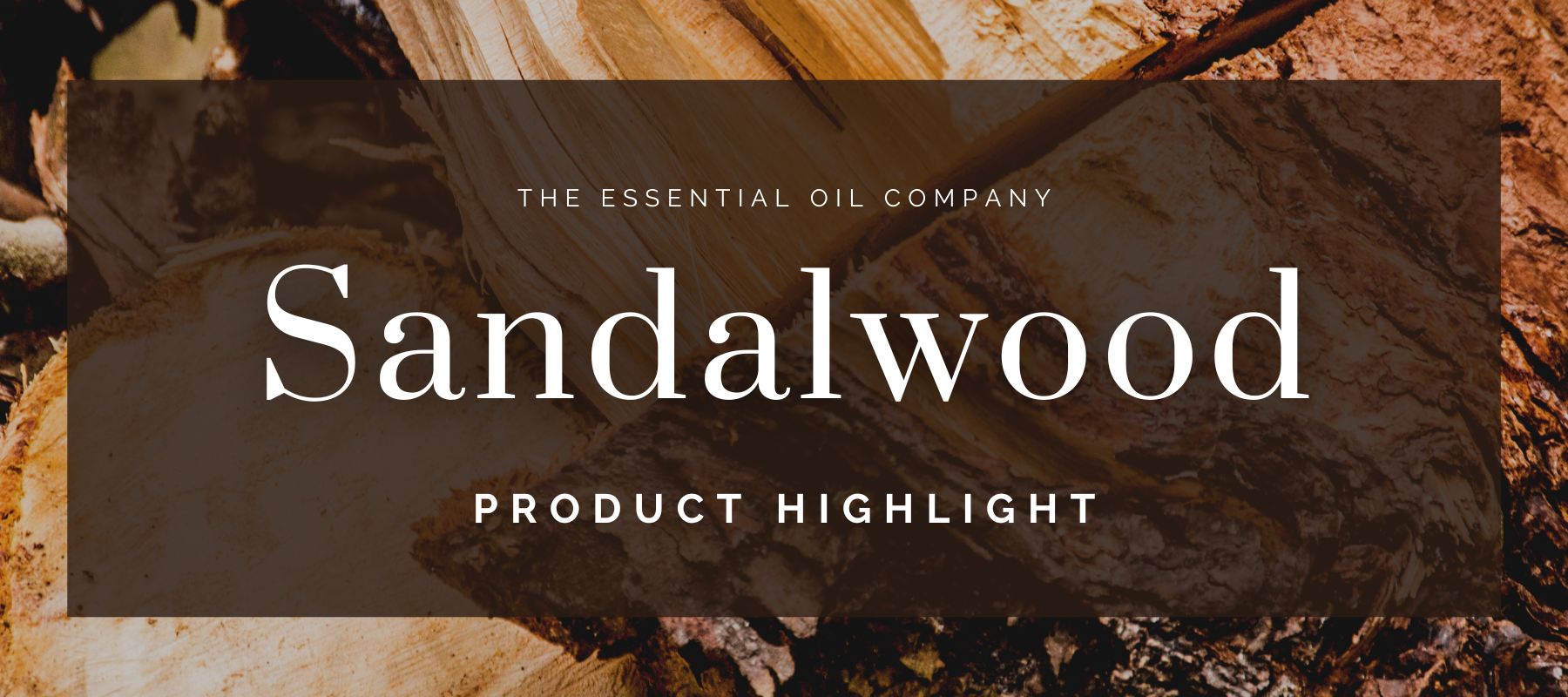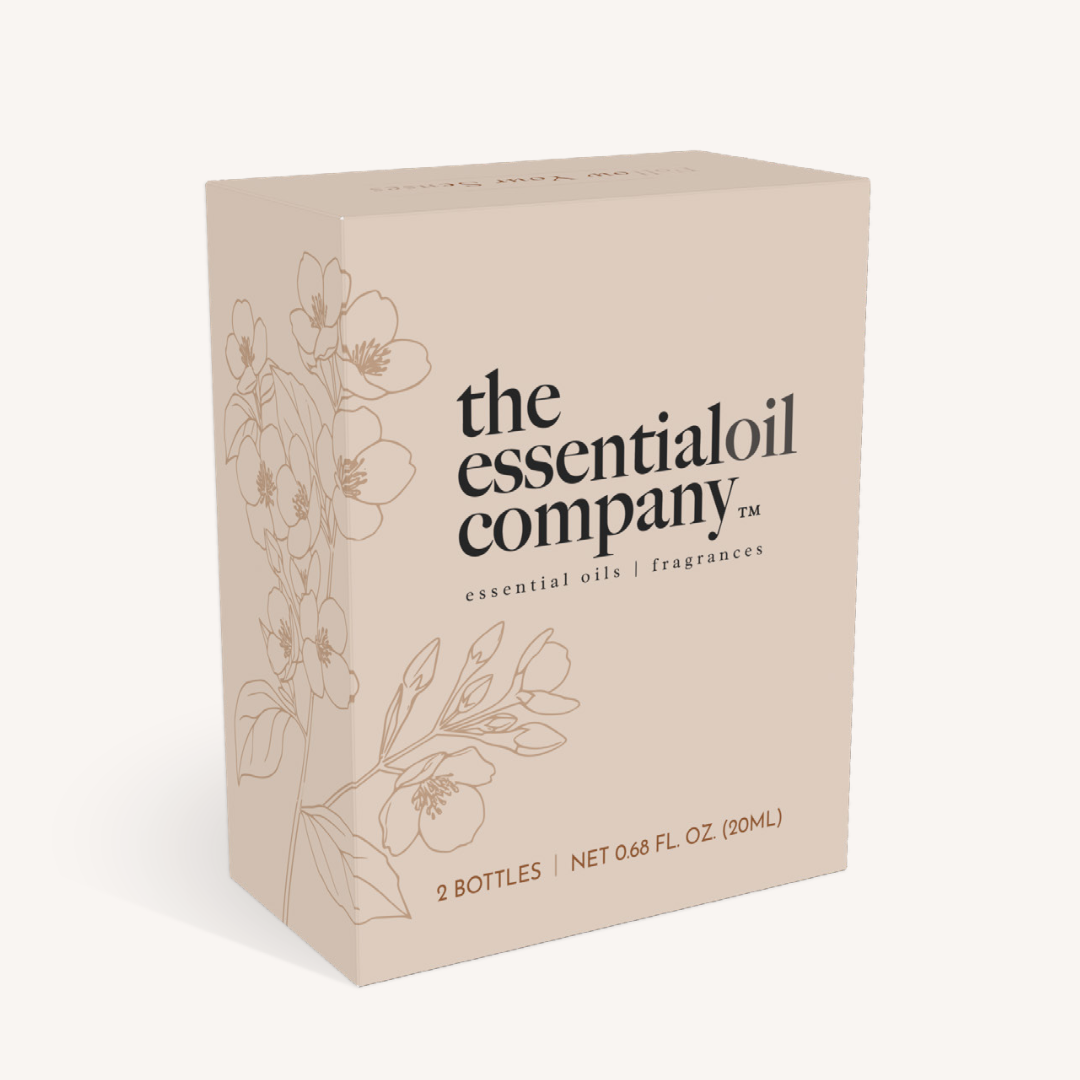Plant Details
Sandalwood Oil comes from trees in the Santalum genus, the two main species for essential oil production are Santalum album and Santalum spicatum. The trees are native to India, Australia, and Hawaii. Sandalwood trees are deciduous and grow up to forty feet tall. The trees have slender branches and smooth grayish-brown bark. The heartwood of the tree is heavy, yellowish to red in color, and has a very fine grain. Sandalwood leaves are shiny and leathery and the flowers are small, very aromatic, and pink to purple in color. Sandalwood trees are very hardy and capable of growing in a variety of climates, thriving in poor and sandy soils. The trees are tolerant to drought, winds, and extreme heat conditions. Despite being hardy to different conditions, young Sandalwood trees are parasitic to “host species” which is required for successful early growth. Sandalwood trees extend specialized roots to nearby trees and siphon nutrients from them for the first seven years or so of their life.
There are around thirty different species of Sandalwood trees but only a few are used for essential oil production. East Indian Sandalwood (Santalum album) produces the finest quality essential oil. Sandalwood Essential Oil has dramatically increased in price because of the tree’s slow growth and high demand for the essential oil of this endangered species. Sandalwood Essential Oil is not present in high enough quantity or quality in Sandalwood trees until they reach about fifteen to thirty years old. The oil develops in the roots and heartwood of the tree. It can take up to sixty years for a Sandalwood tree to be ready for essential oil harvest, although newer production of essential oil starts with trees as young as 15 years old in modern plantations.
History
Sandalwood has been used long throughout history with documents of its use dating back four thousand years, starting in India and spreading through ancient Greece, Rome, and Egypt. Ancient Arab cultures also utilized powdered sandalwood to make incense and perfumes. The wood of the tree was used to build monastery and temple sculptures in China, Tibet, and Nepal. East Indian Sandalwood Oil has been used as an ingredient in traditional and Chinese medicine as well as Ayurvedic practices for hundreds of years. Medicinally, it is used to help treat inflammation, infections, cold symptoms, and muscle pains.
Sandalwood has long been considered sacred and has a history of use in religious and spiritual practices. It has been used to build temples and other sacred structures. In Egypt, Sandalwood was used in the embalming of bodies and religious rituals. Hindus, Buddhists, and Muslims in India burn Sandalwood incense in a practice meant to help elevate the souls of recently deceased loved ones. Sandalwood is still often used in spiritual practices in India. It is used to aid meditation and facilitate divine communication. Sandalwood is often burned on altars and is considered one of three essential incenses, along with Agarwood and Clove, in some Buddhist practices.
In recent years the commercial uses of Sandalwood trees have been drastically limited due to over-harvesting. It is now most commonly used for the production of essential oil, highly valued in both the fragrance and aromatherapy industries.
Extraction
Harvesting cultivated Sandalwood trees for essential oil production begins when the trees are fifteen years old. Sustainability is very important for this endangered species. The trees must be carefully uprooted for harvest since the essential oil is spread throughout the roots, trunk, and branches. The trees are typically harvested in the rainy season when the essential oil content is at its highest. The sapwood and bark are often removed before distillation to expose the heartwood which contains the essential oil. Once harvested, the heartwood and roots are sometimes ground into a coarse powder to maximize the quality of the extraction. Sandalwood essential oil is extracted from the heartwood and roots of the tree through steam distillation. The resulting oil has a thin consistency and is a pale yellow to gold. The aroma of Sandalwood Essential Oil can be described as rich, sweet, and woodsy and its unique scent is highly prized.
Benefits
When used in aromatherapy, Sandalwood Essential Oil is well-loved for its calming and uplifting properties that can help balance emotions. It works to ground our thoughts and impart mental clarity. Sandalwood Essential Oil is known to enhance the mood by reducing tension and anxiety while promoting feelings of balance and calm. It can combat negative energy and increase alertness, while also fostering a sense of spiritual and mental wellbeing. These benefits for the mind and body make Sandalwood Essential Oil useful in meditation practices and allow it to improve sleep quality. It has been known as an aphrodisiac, working to improve intimate connections and facilitate feelings of comfort and sensuality. The calming and soothing properties of Sandalwood Essential Oil can help to ease discomfort from headaches as well as coughs and cold symptoms.
Used topically, Sandalwood Essential Oil is both hydrating and gently cleansing, making it suitable even for those with sensitive skin. It can help balance the oils of the skin for a smooth and clear complexion. Sandalwood Essential Oil’s astringent properties work to improve the appearance of acne and cleanse the pores. It is soothing and replenishes moisture to help brighten and tighten tired and dull skin tones. Sandalwood Essential Oil contains properties that bolster healthy and smooth-looking hair. It works to moisturize the scalp and restore softness in dry and damaged hair. This oil's balancing properties come through in hair applications as it keeps hair at the correct hydration level to enhance shine, volume, and body.
The beautifully rich and unique scent of Sandalwood Essential Oil makes it prized in perfumery. It is a base note that makes an excellent fixative for perfumes and can help to support less intense middle notes in a blend. Australian Sandalwood Essential Oil has a lower santalol content than Indian and Pacific Sandalwoods, which makes it a popular choice for perfumery when a more "woodsy" aroma is desired. Sandalwood Essential Oil blends well with many other oils, especially Patchouli, Rose, Jasmine, Vetiver, and Ylang Ylang.
Here are some recipes using Sandalwood Essential Oil that we love...

Peaceful Mind Diffuser Blend
Ingredients
- 3 drops of Sandalwood Essential Oil
- 3 drops of Cedarwood Essential Oil
- 2 drops of Lime Essential Oil
- 2 drops of Juniper Berry Essential Oil
Instructions
Add water to your diffuser up to the fill line. Add drops of the essential oil blend. This diffuser blend recipe is formulated for a 200ml ultrasonic diffuser. Adjust the amount according to the size and directions of your diffuser.

Serene Woods Perfume
Ingredients
- 8 oz Amber Glass Bottle with Spray Top
- 3 oz of Distilled Water
- 4 oz of High Percentage Alcohol
- 5 ml of Vegetable Glycerin
- 5 ml of Fractionated Coconut Oil
- 10 drops of Australian Sandalwood Essential Oil
- 10 drops of Bergamot Essential Oil
- 10 drops of Rosewood Essential Oil
- 5 drops of Ylang Ylang Essential Oil
Instructions
Add all ingredients to the bottle and shake well to combine. Spritz all over your body for a unique earthy scent. Shake before each use.

Silky Soft Hair Oil
Ingredients
- 2 oz Amber Bottle with Dropper
- 1 oz of Sweet Almond Oil
- 1 oz of Jojoba Oil
- 10 drops of Rosemary Essential Oil
- 8 drops of Sandalwood Essential Oil
- 6 drops of Sage Essential Oil
Instructions
Add all ingredients to the bottle and give it a good shake to combine. Add a few drops to your hands and rub through the ends of hair to nourish and smooth.

Soothing Face Serum
Ingredients
- 2 oz Amber Glass Bottle with Dropper
- 1 oz of Sweet Almond Oil
- ½ oz of Jojoba Oil
- ½ oz of Vegetable Glycerine
- 6 drops of Sandalwood Essential Oil
- 6 drops of Lavender Essential Oil
Instructions
Add jojoba oil, sweet almond oil, and vegetable glycerin into a small dish and whisk them together until they are fully combined. Add the essential oils and stir again. Try to avoid adding too much air into the mixture as you stir to prevent bubbles. Transfer the mixture carefully into a 2-ounce amber glass bottle with a dropper top for easy use. After cleansing your face, apply a few drops to your fingertips and gently rub the serum into the skin. Use fingertips to press the product into the skin to ensure absorption.

Meditating Room Spray
Ingredients
- 4 oz Amber Glass Bottle with Spray Top
- 2 oz of High Percentage Alcohol
- 2 oz of Witch Hazel Extract
- 10 drops of Sandalwood Essential Oil
- 10 drops of Eucalyptus Essential Oil
- 5 drops of Patchouli Essential Oil
Instructions
Add 2 oz of high percentage alcohol to the bottle. Add the essential oils and fill the remainder of the bottle with witch hazel, leaving a little space at the top. Shake well before each use.






